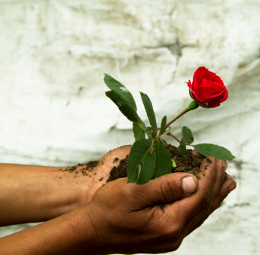Need to know what is the correct method of transplanting roses so that you don't harm them and they continue to bloom in the garden? The following sections will help you understand how to go about transplanting rose bushes the right way.

You have a beautifully exquisite garden of roses that evokes much pride and warmth in your heart. But with the construction of a rock garden on the site of the bushes, there is no other choice but that of transplanting the roses. Of course, an even more beautiful garden of roses awaits you... on the other side. But there's always the fear, the doubt about transplanting rose bushes well enough so that they aren't harmed and continue to bloom the way they did in their original position. So I get that you're in the need of knowing the correct methods of transplanting roses. Let's get you those in the following sections.
Transplanting a Rose Bush
Transplanting the rose bushes should be done properly so that the roses continue to bloom. For this, varied factors like the variety of roses and the time of the year will come into play. Let us try and understand what some of these factors are.
Right Timing
Take into consideration the timing of the year when you are going about the process. It has been seen that late winter to early spring is the best time to carry this forth. It is during this time that the rose plants are in their dormancy and therefore the shock of being transplanted and acclimatizing themselves to a completely new environment will be lowered. They aren't in bloom either so that will make it easier for them. Even though roses are usually transplanted in early spring, transplanting them in the summer or fall can be done just as successfully if the right steps of transferring are taken.
Preparing for Transplanting
Select the area where you want to transplant the roses. Dig individual holes of 15-18 inches in depth and 20 inches in width. Maintain a 10 inch gap between each hole. Next, prepare the soil by mixing it with organic matter so that the roots of the plant have sufficient nutrition when transferred. Water the soil and keep it moist. Pruning the roses before the transplanting process is necessary for maintaining their health.
Digging Out the Rose Bush
Water the rose bush for a week before transplanting it. This will allow the roots to have maximum moisture and help in the process. Dig a clean circular hole that is about 10 inches against the roots of the roses. Slowly dig with a spade, being careful not to harm the root which can be achieved by making the soil loose with water. Dig for about 10 inches and try and collect whatever roots you can. Anything beyond that needs to be cut out with clean strokes. Dig deeper till you reach the ball of the roots and can dig the entire bush out. Dig it out and let the soil fall off from the root surface. In case of transplanting climbing roses, you'll need to untie the rose canes and carefully tie them so that the roots don't break. Then follow the same method of transplanting those roses.
Transplanting the Roses
Make a mound of soil to place the plant on. Place the plant on the mound and take special care in spreading the roots out. After the plant has been placed on the mound, fill the surrounding hole half way over and then pour water over it so that it spreads around. Let the water dry out. After it does, fill the hole with more soil. Make a ring around the rose bush at the roots and water. This will help hold the water in. Once this water has been soaked in, add more soil. Add an inch of fertilizer and mulch over the roots so that it continues to get the required nutrition. Water the plants with an inch of water every week thereafter.
Transplanting roses is not that difficult once you know the kind of precautions and steps you need to take for making this happen, and with that knowledge in hand, we're sure you'll will transfer the roses just fine and make them bloom right through.






 You have a beautifully exquisite garden of roses that evokes much pride and warmth in your heart. But with the construction of a rock garden on the site of the bushes, there is no other choice but that of transplanting the roses. Of course, an even more beautiful garden of roses awaits you... on the other side. But there's always the fear, the doubt about transplanting rose bushes well enough so that they aren't harmed and continue to bloom the way they did in their original position. So I get that you're in the need of knowing the correct methods of transplanting roses. Let's get you those in the following sections.
You have a beautifully exquisite garden of roses that evokes much pride and warmth in your heart. But with the construction of a rock garden on the site of the bushes, there is no other choice but that of transplanting the roses. Of course, an even more beautiful garden of roses awaits you... on the other side. But there's always the fear, the doubt about transplanting rose bushes well enough so that they aren't harmed and continue to bloom the way they did in their original position. So I get that you're in the need of knowing the correct methods of transplanting roses. Let's get you those in the following sections.